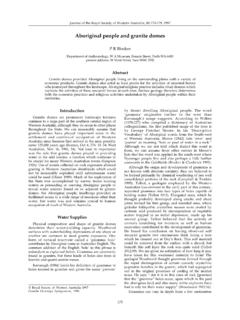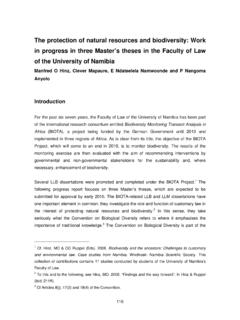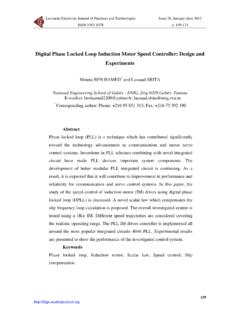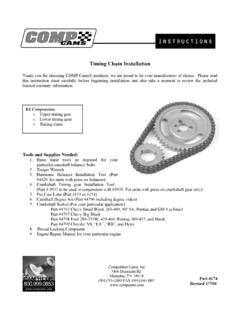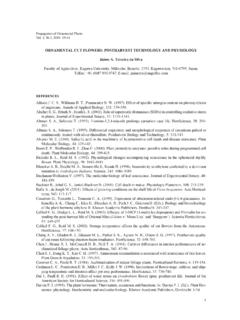Transcription of Graphing Made Easy with SG Procedures - SAS …
1 1 Paper 174-2011 Graphing made easy with SG Procedures Susan J. Slaughter, Avocet Solutions, Davis, CA Lora D. Delwiche, University of California, Davis, CA ABSTRACT New with SAS , ODS Graphics introduces a whole new way of generating graphs using SAS. with just a few lines of code, you can create a wide variety of high-quality graphs. This paper covers the three basic Statistical Graphics (SG) Procedures SGPLOT, SGPANEL and SGSCATTER. SGPLOT produces single-celled graphs. SGPANEL produces multi-celled graphs that share common axes. SGSCATTER produces multi-celled graphs that may use different axes. This paper shows how to use each of these Procedures to produce different types of graphs, how to send your graphs to different ODS destinations, how to access individual graphs, and how to specify properties of graphs, such as format, name, height and width. INTRODUCTION When ODS Graphics was originally conceived, the goal was to enable statistical Procedures to produce sophisticated graphs tailored to each specific statistical analysis, and to integrate those graphs with the destinations and styles of the Output Delivery System.
2 In SAS , over 60 statistical Procedures have the ability to produce graphs using ODS Graphics. A fortuitous side effect of all this graphical power has been the creation of a set of Procedures for creating stand-alone graphs (graphs that are not embedded in the output of a statistical procedure). These Procedures all have names that start with the letters SG. This paper compares the three Procedures that create graphics SGPLOT, SGPANEL, and SGSCATTER. SGPLOT creates one or more graphs and overlays them on a single set of axes. SGPANEL is similar to SGPLOT except that SGPANEL produces a panel of graphs based on one or more classification variables. In SGPANEL all the graphs must use the same axes. SGSCATTER also produces a panel of graphs, but those graphs may use different axes. SGPLOT and SGPANEL share similar statements, but SGSCATTER uses a separate set of statements. The SGRENDER and SGDESIGN Procedures are different.
3 They do not create graphs; instead they render graphs that have been previously defined. SGRENDER renders graphs from custom ODS graph templates that you create using the TEMPLATE procedure. SGDESIGN renders graphs from SGD files that you create using the ODS Graphics Designer, a point-and-click application. SGRENDER and SGDESIGN are not covered in this paper. This paper was written using SAS Phase 2, but almost all the features discussed here also work in SAS Phase1. For those features that are new with Phase 2, we note the differences in their descriptions. ODS GRAPHICS VS. TRADITIONAL SAS/GRAPH To use ODS Graphics you must have SAS/GRAPH software which is licensed separately from Base SAS. Some people may wonder whether ODS Graphics replaces traditional SAS/Graph Procedures . No doubt, for some people and some applications, it will. But ODS Graphics is not designed to do everything that traditional SAS/Graph does, and does not replace it.
4 For example, ODS Graphics does not currently create contour plots; for contour plots you need to use PROC GCONTOUR which is part of traditional SAS/GRAPH. Here are some of the major differences between ODS Graphics and traditional SAS/GRAPH Procedures . Traditional SAS/GRAPH ODS Graphics Graphs are saved in SAS graphics catalogs Graphs are saved in standard image file formats such as PNG and JPEG Graphs are viewed in the Graph window Graphs are viewed in standard viewers such as a web browser for HTML output Can use GOPTIONS statements to control appearance of graphs GOPTIONS statements have no effect Hands-on WorkshopsSASG lobalForum2011 2 VIEWING ODS GRAPHICS When you produce ODS Graphics in the SAS windowing environment, for most output destinations a window opens to display your results.
5 However, when you use the LISTING destination, graphs are not automatically displayed. Regardless of its destination, you can always view a graph by double-clicking its graph icon or name in the Results window. EXAMPLES AND DATA The purpose of this paper is to compare the three major SG Procedures SGPLOT, SGPANEL, and SGSCATTER. The following examples show a small sample of the types of graphs these Procedures can produce, and are designed to illustrate default behaviors. As you read this, keep in mind that there are many other types of graphs (especially for SGPLOT and SGPANEL) and many options. The tables at the end of this paper list all the basic statements and many of the options. For examples using options and optional statements for changing the appearance of plots, see Slaughter & Delwiche (2010). The examples in this paper use data about the 196 countries that participated in the 2008 Olympics.
6 SGPLOT PROCEDURE SGPLOT produces many types of graphs. In fact, this one procedure produces 16 different types of graphs. SGPLOT creates one or more graphs and overlays them on a single set of axes. There are four axes in a set: left, right, top, and bottom. BAR CHARTS Bar charts show the distribution of a categorical variable. This example uses a VBAR statement to create a vertical bar chart of the variable Region. The chart shows the number of countries in each region. PROC SGPLOT DATA = Countries; VBAR Region; TITLE 'Olympic Countries by ' 'Region'; RUN; Hands-on WorkshopsSASG lobalForum2011 3 This bar chart is like the first one except that the bars have been divided into groups using the GROUP= option. The grouping variable is a categorical variable named PopGroup. The GROUP= option can be used with most types of plots in SGPLOT, SGPANEL, and SGSCATTER.
7 PROC SGPLOT DATA = Countries; VBAR Region / GROUP = PopGroup; TITLE 'Olympic Countries by Region ' 'and Population Group'; RUN; In the following code, the GROUP= option has been replaced with a RESPONSE= option. The response variable is NumParticipants, the number of participants in the 2008 Olympics from each country. Now each bar represents the total number of participants for a region. PROC SGPLOT DATA = Countries; VBAR Region / RESPONSE = NumParticipants; TITLE 'Olympic Participants by ' 'Region'; RUN; HISTOGRAMS AND DENSITY PLOTS Histograms show the distribution of a continuous variable. Density plots show standard distributions (either NORMAL or KERNEL) for the data, and are often drawn on top of histograms. When overlaying plots, the order of the statements determines which plot is drawn on top. The plot resulting from the first statement will be on the bottom, followed by the second, and so on.
8 Care must be taken to make sure that subsequent plots do not obscure the first. In this example, the HISTOGRAM statement draws the distribution of the variable, TotalMedals, which is the total number of medals won by each country. The DENSITY statement overlays a density plot on top of the histogram. The default density plot is the normal distribution. Hands-on WorkshopsSASG lobalForum2011 4 PROC SGPLOT DATA = Countries; HISTOGRAM TotalMedals; DENSITY TotalMedals; TITLE 'Total Medals for ' 'Olympic Countries'; RUN; SCATTER PLOTS Scatter plots show the relative distribution of two continuous variables on Cartesian coordinates. To create a scatter plot, use a SCATTER statement. This example produces a scatter plot of the number of participants per country versus the total number of medals won. *Scatter plot using SGPLOT; PROC SGPLOT DATA = Countries; SCATTER X = NumParticipants Y = TotalMedals; TITLE 'Number of Participants ' 'by Total Medals Won ' 'for Each Country'; RUN; SGPANEL PROCEDURE The SGPANEL procedure produces nearly all the same types of graphs as SGPLOT, but instead of displaying only one plot per image, SGPANEL displays a panel of plots in a single image.
9 A separate plot is produced for each level of the variable you specify in the PANELBY statement. The syntax for SGPANEL is almost identical to SGPLOT, so it is easy to convert SGPLOT code to SGPANEL by making just a couple of changes to your code. You simply replace the SGPLOT keyword with SGPANEL, and add a PANELBY statement. The PANELBY statement must appear before any statements that create plots. This example takes the preceding SGPLOT example and converts it to an SGPANEL. The PANELBY statement produces a separate plot for each value of Region. Hands-on WorkshopsSASG lobalForum2011 5 *Scatter plots using SGPANEL; PROC SGPANEL DATA = Countries; PANELBY Region; SCATTER X = NumParticipants Y = TotalMedals; TITLE 'Number of Participants ' 'by Total Medals Won ' 'for Each Country'; RUN; The variable Region used in the PANELBY statement happens to have an even number of values so it creates a nice rectangular panel.
10 If your PANELBY variable has an uneven number of values, then you may end up with empty cells in your panel. You can use the ROWS= and COLUMNS= options to change the shape of your panel. You may also want to use the NOVARNAME option to remove the name of the PANELBY variable from the graph, and the SPACING= option to separate the cells making them more distinct. *SGPANEL with options; PROC SGPANEL DATA = Countries; PANELBY Region / SPACING = 5 NOVARNAME ROWS=6; SCATTER X = NumParticipants Y = TotalMedals; TITLE 'Number of Participants ' 'by Total Medals Won'; RUN; Hands-on WorkshopsSASG lobalForum2011 6 SGSCATTER PROCEDURE At first glance, the SGSCATTER procedure appears similar to SGPANEL because both Procedures produce multi-celled graphs. However, while SGPLOT and SGPANEL share the same statements for producing plots, SGSCATTER uses a completely different (and much smaller) set of statements.










